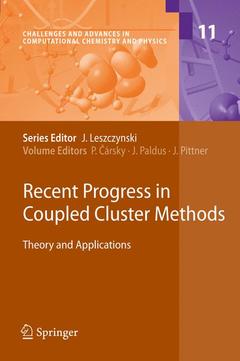Recent Progress in Coupled Cluster Methods, 2010 Theory and Applications Challenges and Advances in Computational Chemistry and Physics Series, Vol. 11
Coordonnateurs : Cársky Petr, Paldus Josef, Pittner Jirí

P. Cársky is a Senior Scientist at the Heyrovský Institute and external professor at the Charles University
J. Paldus is a Distinguished Professor Emeritus at the University of Waterloo, Canada
J. Pittner is the Head of the Department of Theoretical Chemistry at the Heyrovský Institute
P. Cársky was a coauthor of the following books:
R. Zahradník, P. Cársky: Organic Quantum Chemistry Problems. Plenum Press, New York 1973, 222 p.
New editions:
Hirokawa Publishing Company, Tokyo, 1979 (in Japanese), SNTL, Praha 1978 (in Czech).
R. Zahradník, P. Cársky: Sbírka úloh z aplikací kvantové chemie. Statní pedagogické nakladatelství, Praha 1967, 174 p (in Czech).
P. Hobza, P. Cársky, J. Pancír, R. Zahradník: Výklad k programum pro kvantove chemické výpocty. Státní pedagogické nakladatelství, Praha 1972, 140 p (in Czech).
P. Cársky, J. Pancír, R. Zahradník: Molekulové orbitaly v chemii. Academia, Praha 1974, 140 p (in Czech).
P. Cársky, M. Urban: Ab Initio Calculations. Methods and Applications in Chemistry. Lecture Notes in Chemistry, Vol. 18. Springer-Verlag, Berlin 1980, 247 p.
Czech edition: Ab initio výpocty v chemii. SNTL, Praha 1985, 279 p. J. Paldus contributed numerous Chapters to various monographs and is currently on several Editorial Boards (in particular for a book series "Advances in Quantum Chemistry" published by Academic Press).
Date de parution : 09-2012
Ouvrage de 657 p.
15.5x23.5 cm
Date de parution : 07-2010
Ouvrage de 657 p.
15.5x23.5 cm
Disponible chez l'éditeur (délai d'approvisionnement : 15 jours).
Prix indicatif 316,49 €
Ajouter au panier


